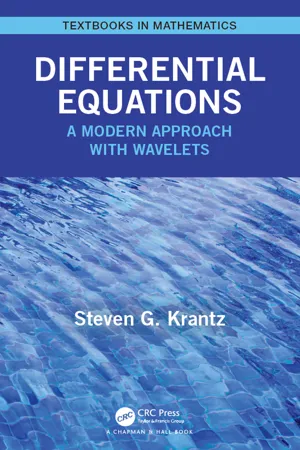
- 467 pages
- English
- ePUB (mobile friendly)
- Available on iOS & Android
About this book
This new book from one of the most published authors in all of mathematics is an attempt to offer a new, more modern take on the Differential Equations course. The world is changing. Because of the theory of wavelets, Fourier analysis is ever more important and central. And applications are a driving force behind much of mathematics.This text text presents a more balanced picture. The text covers differential equations (both ordinary and partial), Fourier analysis and applications in equal measure and with equal weight. The Riemann integral is used throughout. We do not assume that the student knows any functional analysis. We likewise do not assume that the student has had a course in undergraduate real analysis. To make the book timely and exciting, a substantial chapter on basic properties of wavelets, with applications to signal processing and image processing is included. This should give students and instructors alike a taste of what is happening in the subject today.
Frequently asked questions
- Essential is ideal for learners and professionals who enjoy exploring a wide range of subjects. Access the Essential Library with 800,000+ trusted titles and best-sellers across business, personal growth, and the humanities. Includes unlimited reading time and Standard Read Aloud voice.
- Complete: Perfect for advanced learners and researchers needing full, unrestricted access. Unlock 1.4M+ books across hundreds of subjects, including academic and specialized titles. The Complete Plan also includes advanced features like Premium Read Aloud and Research Assistant.
Please note we cannot support devices running on iOS 13 and Android 7 or earlier. Learn more about using the app.
Information
1
What Is a Differential Equation?
1.1 Introductory Remarks
(1.1.1) |
Table of contents
- Cover
- Half Title
- Series Page
- Title Page
- Copyright Page
- Dedication
- Table of Contents
- Preface for the Instructor
- Preface for the Student
- 1 What Is a Differential Equation?
- 2 Second-Order Linear Equations
- 3 Power Series Solutions and Special Functions
- 4 Sturm–Liouville Problems and Boundary Value Problems
- 5 Numerical Methods
- 6 Fourier Series: Basic Concepts
- 7 Laplace Transforms
- 8 Distributions
- 9 Wavelets
- 10 Partial Differential Equations and Boundary Value Problems
- Table of Notation
- Glossary
- Bibliography
- Index